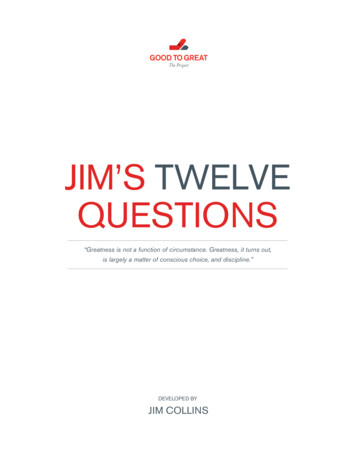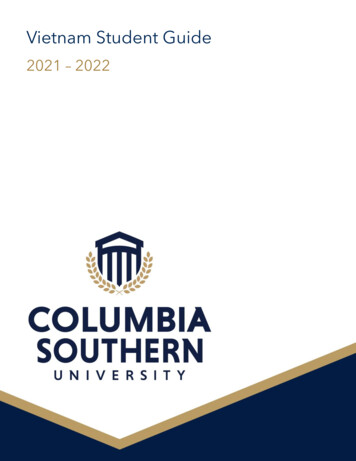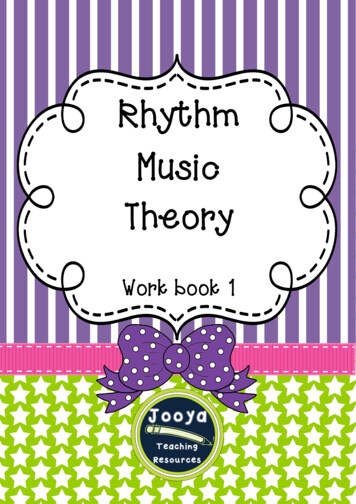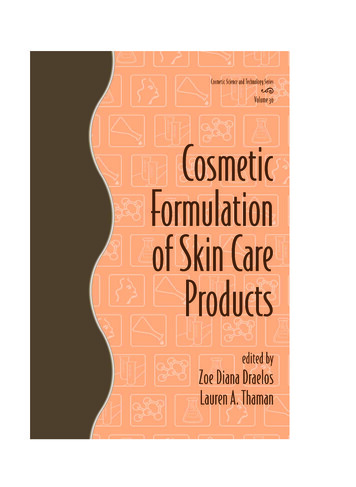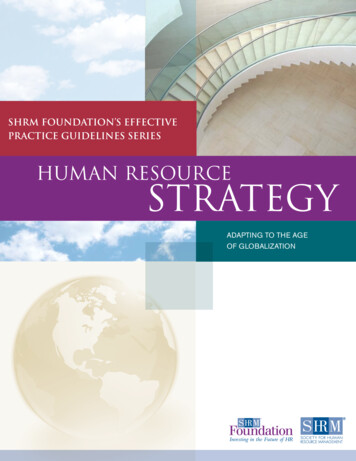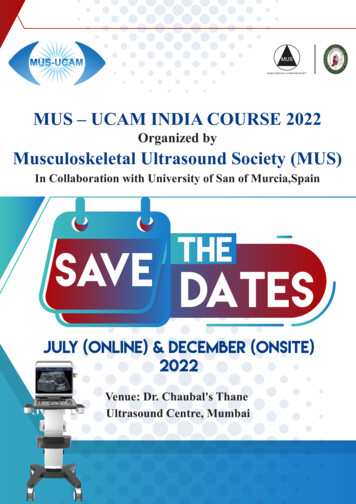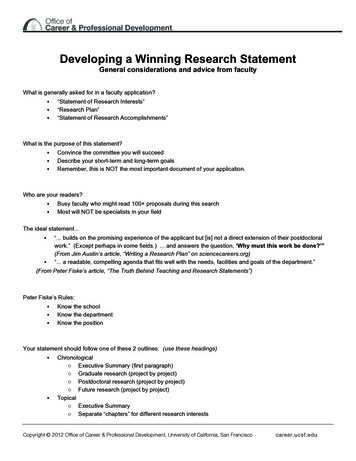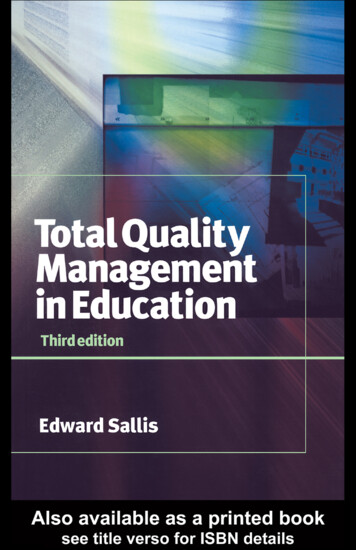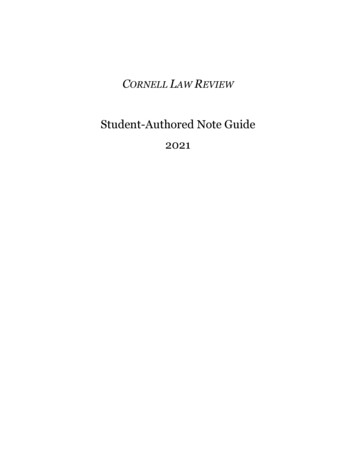
Transcription
CORNELL LAW REVIEWStudent-Authored Note Guide2021
Table of ContentsINTRODUCTION . 3WHAT IS A NOTE?. 4COMMON NOTE TYPES . 4NOTE TYPES TO AVOID . 5RECENT EXAMPLES. 6STRUCTURE . 7CHOOSING A NOTE TOPIC. 9PREEMPTION. 11WHAT IS PREEMPTION? . 11PREEMPTION CHECKS . 11NOTE SELECTION & PUBLICATION . 13ELIGIBILITY . 13SELECTION PROCESS . 13CRITERIA FOR SELECTION. 14FORMATTING & EXPECTATIONS. 15AUTHOR FEEDBACK . 15NOTE-ON METHOD. 17DATES & DEADLINES. 18CONCLUSION . 19Cornell Law Review Student-Authored Note Guide 20212
IntroductionThrough its Note Office, the Cornell Law Review seeks to promote student authorship by selectingtwo student-authored Notes for publication in each of its six (when there is a symposium issue) orseven issues (when there is not a symposium issue) per volume. While Volume 106 has seven issueswith Notes, Volume 107 will only have six issues with Notes since it will have a symposium issue onthe Death Penalty. The Cornell Law Review believes the Note-writing process provides tremendouspotential for growth as a thinker and academic, as well as invaluable research and writing skills.This guide discusses the Cornell Law Review’s Note expectations and guidelines for writing Notesfor publication. Specifically, this guide details each stage of the Note-writing process, including notetypes, topic selection, preemption, the selection process, formatting, and submission deadlines.Additionally, this guide explains the Cornell Law Review’s Note-on method. If a Note selected forpublication was authored by a student not currently on the Cornell Law Review, that student will beoffered an Associate position on the Cornell Law Review during their third year. All 2Ls, includingtransfer students, are eligible to participate in the Cornell Law Review’s Note-on program.Cornell Law Review Student-Authored Note Guide 20213
What is a Note?A Note is a piece of legal scholarship written by a student that identifies a specific, unresolvedlegal problem and offers a solution. Notes are shorter than Articles–typically about 30 to 40pages in length–and much narrower in scope. Unlike Articles, Notes rarely present ideas fordoctrinal frameworks, approaches, or developments, but, rather, are vehicles for focusing andsolving discrete legal problems.A Note is a piece of writing that critically analyzes an aspect of the law. Notes take clearpositions on the issues they address and solutions they propose. Since they are academiccontributions, they must recognize all sides of the issue discussed and be as objective aspossible. By doing so, a Note’s author assures their reader that nothing is being hidden, andso lends credibility to the position they ultimately take. In short, a Note author shouldarticulate their position forcefully while treating contrary arguments seriously andrespectfully.Below is a summary of the Note types that are typically published in the Cornell LawReview. While these Note types are most frequently published, occasionally, other, lesscommon Note types are selected by the Notes Selection Committee. Below is a also a list ofNote types that the Cornell Law Review Notes Office recommends that authors avoid.Throughout the Note selection period, the Senior Notes Editor noted patterns of Note typesthat were not selected for publication. These Notes were often eliminated because they failedto adequately analyze the problem, the solution was not novel or discrete enough, or theimpact of the scholarship on the legal community was marginal. To aid students in theirNote-writing process, this section provides a list of recently-selected Notes for publication inthe Cornell Law Review, as well as provides an outline of the structure of Notes commonlyselected for publication.Common Note Types The Case Note: A case Note typically explains the impact of a recent case or statutewithin the existing framework of the law. Case Notes usually treat issues of nationalimportance, focusing on Supreme Court decisions, acts of Congress, or rulings byfederal administrative bodies. International topics are also appropriate for case Notes.State law case Notes are feasible; however, if you should decide to write about a statecourt decision or statute, you should aim to select one that is of national significance.One may also write a case Note that anticipates a court decision or statute. For example,such a Note might discuss a pending lawsuit or bill. The ripeness of these topics is aconcern, however, because if the lawsuit is dropped or the legislation falls through thecracks, your Note may end up not being publishable. Most case Notes generally includea background, a discussion of the case or statute at issue, and an analysis of the decisionor law. Some writers may be troubled by the limitations of the case Note. Case Notes areessentially reactive in nature. Instead of actively exploring problems in the law andproposing new solutions, you may find yourself limited to discussing ideas proposed byjudges or elected officials. While this may suit some authors, others may seek a moreforward-looking topic. The Scope Note: Instead of focusing on a single case or statute, a scope Notediscusses a single issue and analyzes approaches to this issue across a certain area of thelaw. A scope Note might, for example, compare and contrast solutions that differentstate courts have adopted in reaction to the same problem, or it might discuss the effectof several Supreme Court decisions concerning a particular issue within the last year. Itmight also address the impact of a certain current event upon different areas of the lawor provide a statistical analysis of a very large number of cases. The scope Note providesCornell Law Review Student-Authored Note Guide 20214
a limitless range of topics and has a lower risk of preemption. Keep in mind, however,that a good scope Note requires mastery of the issue in question, which involves a greatdeal of time and research. The Circuit Split Note: When two or more federal circuit courts or district courtsdisagree on an important legal issue, the Supreme Court will often grant certiorari toprovide a uniform answer. A circuit split Note attempts to beat the Supreme Court tothe chase and proposes its own novel resolution of the circuit split. A circuit split Noteshould go beyond a “Circuit A is right and Circuit B is wrong” analysis and shouldinstead propose a novel solution, possibly one that neither circuit court had considered.If persuasive enough, your Note may even influence the determination of the issueshould the Supreme Court grant certiorari. Student Notes are sometimes cited in briefssubmitted to the Supreme Court, and occasionally are cited in the Court’s decision.Preemption, however, is a constant concern. The Supreme Court may resolve the splitbefore you publish, rendering your thesis moot. Furthermore, because circuit splits arecommon Note topics, another law student may preempt your topic by publishing a Notecovering the same ground and making substantially similar arguments. The Multi-Disciplinary Note: Notes that borrow insights or analyses from otherdisciplines can shed light on legal thinking. A multidisciplinary Note analyzes the law inrelation to other fields of study, such as history, economics, philosophy, religion, or thesciences. The Note might, for example, discuss the historical development of a rule oflaw or analyze an issue in the law with respect to a specific moral philosophy. The fieldof possible topics for a multidisciplinary Note is vast and the author has the freedom toadopt a more proactive stance than with the more traditional Note forms. Those whohave a strong background in another field should strongly consider writing this type ofNote. Should you decide to pursue this kind of Note, however, please keep in mind thatthis is a law review and, therefore, your Note topic must ultimately bear some relation tothe study of law. The Historical Note: Remember that Notes must address a novel, live legal issue.Therefore, a Note that addresses legal history must situate the relevance of that historyin the current debate. Most historical Notes spend the first half of the Note discussingthe historical roots of the problem, and then in the analysis section, explain how thathistory impacts the development of the discrete legal issue of relevance. One note ofcaution: Historical notes can be involving, so be sure not overcommit. The Empirical Research Note: This type of Note is extremely useful but can bedifficult to write, as it’s hard to find an area that can be researched thoroughly in alimited amount of time. On the bright side, empirical Notes are hard to preempt—youare only preempted if someone has done the same (or a similar) empirical study. Justbecause your theory has been articulated elsewhere does not mean that your empiricalNote is preempted. Oftentimes, the empirical research Note builds off of previous Notesand seeks to improve the methodology and research tools. When constructing anempirical research Note, make sure to include an analysis section that describes the dataand methodology used, as well as an analysis section that situates the results of the studyin the broader legal context.Note Types to Avoid The Thought Dump Note: These Notes list an array of observations and conclusionsabout a topic, but largely fails to identify a specific solution that will be meaningful tothe legal community. A Note should identify a specific legal problem and propose anovel, well-articulated solution–it should not be a setting for a thought dump on aninteresting topic.Cornell Law Review Student-Authored Note Guide 20215
The Research Note: These Notes merely summarize the legal landscape of a topicwithout offering critical analysis or novel solutions. Notes should offer more than a meresynopsis of the background of the law—they should provide a novel solution to apreviously unaddressed or topical issue. The Broad-Sweeping Note: A Note like this proposes to tackle broad sweepingtopics without narrowing to a discrete legal issue. Notes should tackle narrow, modesttopics in detail, rather than provide a superficial or conclusory analysis of broaderissues. Note topics should be manageable and focused on one central idea or concept. The “Should” Note: These analyze a specific pending or past case and prescribe howa court “should” or “should have” responded. A Note must address a specific legal issue,not a particular court case. While a legal analysis might find its application within aspecific court case, a Note should not focus entirely on one question before a court.Recent ExamplesThe Notes below are examples of Cornell Law Review pieces that have been recently selectedfor publication. Reading their titles and descriptions will give you a sense of the typical Note’sscope and legal issue. If you would like to view the content of these Notes, many of them areavailable on Cornell Law Review’s website. Thomas Shannan, Are We There Yet? No: The Numbers That Support AdoptingAutomatic Appeals Towards Juvenile Justice Zachary Sizemore, Trending Towards Leniency: What Millenium Laboratories & Inre Plavix Marketing Teach About the Future of the False Claims Act’s First-to-FileRule Hun Lee, Finding Benevolent Neutrality in Land Use: RLUIPA’s Equal TermsProvision and the Human Flourishing Theory of Property Kayla Anderson, Are There Rights in Guantanamo Bay: The Great Writ RingsHollow Andrew Kingsbury, Patenting Pot: The Hazy Uncertainty Surrounding CannabisPatents Lily Coad, Compelling Code: A First Amendment Argument Against RequiringPolitical Neutrality in Online Content Moderation Ji Hyun Rhim, Left at the Gate: How Gate Money Could Help Prisoners ReintegrateUpon Release Lauren Devendorf, Law Abiding, Responsible, and Previously Mentally Ill: The Casefor Applying Strict Scrutiny to Lifetime Bans for Individuals Previously Committedto Mental Institutions Miranda Herzog, “The Intent to Influence”: Jury Tampering Statutes and the FirstAmendment Christopher Johnson, Too Much ‘Acting,’ Not Enough Confirming: TheConstitutional Imbalance Between the President and Senate Under the FederalVacancies Reform Act Michael Mills, The Death of Retaliatory Arrest Claims: The Supreme Courts AttemptCornell Law Review Student-Authored Note Guide 20216
to Kill a Retaliatory Arrest Claims in Nieves v. Bartlett David Eichert, Disciplinary Sodomy: Prison Rape, Police Brutality, and the GenderedPolitics of Societal Control in the American Carceral System Kevin Dong, Developing a Digital Property Law Regime Ashley Mullen, International Cultural Heritage Law: The Link Between CulturalNationalism, Internationalism, and the Concept of Cultural Genocide Benjamin T. Van Meter, Demanding Trust in the Private Genetic Data Market Julia F. Hollreiser, Closing the Racial Gap in Financial Services: BalancingAlgorithmic Opportunity with Legal Limitations Andrew W. Wassef, Executive Privilege with a Catch: How a Crime-Fraud ExceptionPrivilege Would Facilitate Congressional Oversight of Executive Branch Malfeasancein Accordance with the Constitution’s Separation of PowersStructureNotes serve their specific purpose for legal scholars and practitioners best when they meetreaders’ expectations. A Note will therefore be most useful when its structure allows readers toeasily navigate the sections. A good Note describes the background law, explains the problem atissue in the Note, and argues for a solution to the problem. A standard Note achieves thesethree things, while also reflecting wide-reaching, in depth research, evidenced by a broad rangeof sources. Specifically, a Note must cite more than handful of sources and must demonstratethat the author has done extensive research. A standard Note will typically achieve these goalsin 3-4 separate sections that are framed with an Introduction and Conclusion. Introduction: The introduction section should briefly outline the structure of yourNote. The introduction should start with a hook that catches the reader’s attention thatintroduces the crux of the problem you have decided to write about. After the author hassuccinctly introduced the problem, the author should explain what the Note argues andthe author’s proposed solution. The author should then provide a roadmap of thecoming sections, affording one paragraph to each section. Background: This section provides background information and should contain athoughtful discussion that situates the problem in existing literature and the current state ofthe law. Often times, Authors provide a historical context or explain new developmentsin the law in this section. This section often does not comprise original authorconclusions, however, the author should make sure to clearly set up the problem andhow it will be discussed in future sections. Analysis: The analysis section describes in detail the problem your Note addresses andexplains through detailed and critical analysis why it is important. This section alsopresents your proposed solution(s) to the problem. This section should contain a wellreasoned analysis that identifies relevant counterarguments and avoids conclusorystatements. Explain clearly why the problem or issue you address merits close attentionand analysis, and why the existing law (or political climate, etc.) as it stands today, asdescribed in your background section, cannot resolve it or inadequately addresses it. Besure to argue your proposed solution thoroughly, which may require you to address anddismiss potential alternative solutions. This section could be separated into twosections, one detailing the problems and inadequate approaches, and the otherintroducing your novel approach.Cornell Law Review Student-Authored Note Guide 20217
Conclusion: The conclusion should place your proposed solution into the broadercontext of your background section and analysis of the problem. A conclusion istypically less than one page long, and briefly lays out the problem and the author’sproposed solution. Refrain from including too many footnotes or cross references inthis section, and avoid merely summarizing the entire piece.Cornell Law Review Student-Authored Note Guide 20218
Choosing a Note TopicChoosing a viable topic is the most important—and often the most difficult—part of the Notewriting process. You should look for a topic that is timely, manageable, and unique. The sooneryou pick your Note topic, the better. However, you want to be sure to find a topic that providesyou with enough to talk about, that interests you, and that has an important legal impact. Asyou consider topics, here are some questions to ask yourself: Do I have something interesting to say about this case/statute/question? Your thesismust contain a constructive analysis, not merely a passive observation. “This area of thelaw is very confused” is not sufficient. You need to propose a suggestion for the directionof the law. Your position may change throughout the Note-writing process, but youshould feel strongly enough to take a stand. Do I have enough of a professional, personal, or academic interest in this area of the lawto inspire me to work on it for six months? You are going to work hard and spend a lotof time writing your Note, so you may as well pick a topic that you enjoy. What has already been said about this topic? Will my Note make an originalcontribution to the field? You should select a topic and write your Note with the endgoal of having your Note published. When selecting a Note topic, you should considerwhether others would find your proposed thesis interesting and useful.How to choose a topic: Talk to contacts from your summer job. Think back to any memos you wrote or researchyou conducted over the summer. Do you recall any unresolved legal questions thatseemed interesting? Did you conclude any memo or research assignment with “I don’tknow,” either because authorities supported both sides of the question or because it wasunclear how a recent case or statute might impact the subject? Any of the above mightindicate a fledgling Note topic. If nothing Note-worthy sprang from your summerassignments, why not call the people you worked with? Ask them whether they’verecently stumbled on any interesting gray legal areas that might lend themselves tofurther inquiry. Please Note, however, that if you want to write about a case that youworked on last summer, you’ll need to clear it with your former boss. Differentorganizations have different confidentiality policies and concerns, and, as a futuremember of the bar, you should take these concerns seriously. Look for circuit splits or controversies among states. There are several ways to locatecircuit splits:o1. Check out the “Circuit Split Roundup” published by U.S. Law Week, or searchthe Westlaw directory of U.S. Law Week articles. You’ll find this directory inDirectories / Legal Periodicals / Legal Newspaper Databases / BNA UnitedStates Law Week. Search for “circuit /5 split” and add any search terms relatedto your area of interest (you can try the same trick for other legal newspaperdatabases located on Westlaw or Lexis)o2. To find circuit splits that have been identified in judicial decisions, go toWestlaw or Lexis, select the U.S. Courts of Appeals database, and input a fewwords related to your topic. Then add one of the following phrases to your searchterms: (1) circuit or authority! /5 split; (2) “decline to follow” /s circuit orappeals; or (3) disagree /s circuit /s first or second or third or fourth or fifth orsixth or seventh or eighth or ninth or tenth or eleventh or D.C.Cornell Law Review Student-Authored Note Guide 20219
oCheck out some online blogs. SCOTUSblog (http://www.scotusblog.com) oftenmentions splits (but be careful if the issue is too ripe for a cert grant—you don’twant to be preempted).oCasebooks and treatises highlight circuit splits and different treatments amongstates. Check casebook Notes that appears at the end of each subchapter—all theopen-ended questions contained in those Notes are just waiting to be tackled bylaw students!Think of “side effects” stemming from court decisions or legislative enactments. Trylooking at:oEn banc decisions: If an appellate court decided to sit en banc, you can bet thatthe case presents some complicated and important legal issues. En bancdecisions are a great way to find Note topics, especially if the case is narrowlydecided and the dissent makes a persuasive and heated argument. You can finden banc decisions by searching Westlaw or Lexis; select either the U.S. Courts ofAppeals database or the “all states” database, input a few search terms particularto your topic, and then add this seven-word phrase: (“sitting en banc” or“rehearing en banc”).oSCOTUSblog (http://www.scotusblog.com): In addition to gossip and updatesabout the Supreme Court and its cases, you’ll find information about big casesworking their way up the appellate ladder, discussions of ways in which newSupreme Court cases might impact the legal landscape, and links to commentaryin the media, the academy, and the blogosphere. Talk to your professors. Professors also conduct their own legal research and write legalarticles, so they may have already thought of interesting topics worthy of exploration. Take a writing seminar. You may use your seminar paper as the basis for your Note butyour Note must be substantially different from your seminar paper. Be sure to read theinformation in this packet on “Using a Seminar Paper as Your Note.” Please note thatyou must obtain permission from your professor to use a seminar paper as the basis foryour Note and not all professors are willing to grant their permission. Read periodicals. Scan the most recent issues of the National Law Journal, the NewYork Law Journal, and U.S. Law Week. These publications often discuss developmentsin the law and their real-world impact. Magazines and newspapers that are not entirelylegal-focused are also great resources. Browse your favorite newspaper for interestingarticles that may have an interesting connection to the law. Read legal Blogs. Legal blogs are a great way to learn about the “hot” legal issues of theday. Here are links to lists of top legal the 9th annual blawg 100/?utm source internal&utm medium navigation&utm campaign navbarohttp://www.avvo.com/stats/top legal blogsoThe “How Appealing” Blog, at http://howappealing.law.com, rounds up links tothe latest appellate opinions—just the newsworthy or controversial ones. It alsoprovides links to media discussions of appellate opinions. It’s a good place tofind controversial cases, which in turn lead to areas of the law that are unsettled.Cornell Law Review Student-Authored Note Guide 202110
PreemptionWhat is Preemption?The Cornell Law Review wants to publish Notes that will impact the legal community for yearsto come. That’s why your Note must address a “novel legal topic” that has not been preempted.A Note that is preempted will not be selected for publication because it signals that the piece isirrelevant or lacks adequate research.A Note is preempted if it analyzes a legal problem that has already been thoroughly analyzed byother scholars or that has been rendered irrelevant by certain events. It is your Note’s analysisof a legal problem that’s vulnerable to preemption. Even if your Note proposes a new solutionto that problem, it’s preempted if the problem has been analyzed thoroughly elsewhere or hasbecome irrelevant.Preemption is a threat when you’re choosing a topic, when you’re writing your Note, and—ifyour Note is selected—when you’re revising your Note in preparation for publication. Noteauthors can often “write around” preemption, but it generally requires great deal of work.Here are some characteristic, but not exclusive, examples of preemption: If your Note analyzes a circuit split and the Supreme Court grants cert to resolve thesplit, your Note has almost certainly been preempted because, even if your proposedsolution differs from the Court’s decision, your Note longer addresses a “live legalcontroversy.” If your Note analyzes a statute that Congress subsequently substantially amends, yourNote has almost certainly been preempted because your Note discusses an outdatedlegislative regime. If your Note analyzes a legal problem and a professor publishes an article analyzing thesame problem, your Note has almost certainly been preempted even if you propose adifferent solution than the professor because professor’s articles are seen as morepersuasive than a student Note. If your Note analyzes a legal problem and another law student publishes a Note thatanalyses the same problem, your Note has likely been preempted.You should monitor the legal world for preemption threats throughout the Note-writingprocess, and you should treat seriously the preemption checks you conduct.Preemption ChecksTo conduct a preemption check, you must do more than survey some of the pertinent law orscholarly literature on your topic. Rather, you must locate and scrutinize all of it. You shouldbegin your preemption check soon after a topic has begun to engage your serious interest sothat you do not invest too much time researching and writing on a topic already covered bysomeone else.For a preemption check, you will consult an index (in paper or online) or run a full-text, onlinesearch to locate preempting literature in law Journals, law-related Journals, or specializedscholarly Journals.Below are suggested steps when conducting a preemption check:Cornell Law Review Student-Authored Note Guide 202111
1. Construct a list of terms and synonyms to describe your topic. Use Burton’s LegalThesaurus to help you identify alternative language. Use the thesaurus on Westlaw andLexis to expand your term list. Think about what subject headings your topic could fallunder. 2. Search Lexis full-text law reviews AND Westlaw full-text law reviews. Althoughthese databases overlap, each contains articles not available through the other. (Thissearch will cover most of the law review articles written since the mid-1990s.) 3. Search Index to Legal Periodicals and Books on Lexis (LAWREV:ILP) or Westlaw(ILP). This search will cover many more articles than the full-text database search instep two since this index includes almost every law review article written in the UnitedStates since 1980. However, you may retrieve fewer articles than in step two since thisis not a full-text search. 4. To determine whether pending, unpublished legal scholarship will preempt your Notetopic, look at SSRN. SSRN provides a link to a list of Journals and working papers andprovides email abstracts of materials they have accepted for publication but have not yetpublished. 5. If articles on your topic might have been published in a foreign legal Journal, thenyou should search the Index to Foreign Legal Periodicals. This database is updatedquarterly and covers 1985 to the present. To access the Index, go to the Cornell LawLibrary website and click on “Other Online Resources” under the section entitled“Research Tools.” Then, under “Databases by Subject A–F,” go to “Foreign Law” andyou will find “Index to Foreign Legal Periodicals.” (This step is only necessary ifyou need to check foreign Journal articles.) 6. If a book (or book chapter) may have been published a
Cornell Law Review Student-Authored Note Guide 2021 3 Introduction Through its Note Office, the Cornell Law Review seeks to promote student authorship by selecting two student-authored Notes for publication in each of its six (when there is a symposium issue) or seven issues (when there is not a symposium issue) per volume.
